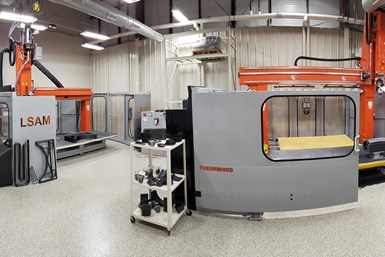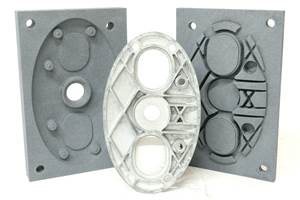DOE Awards Nearly $3 Million to Develop Additive Manufacturing of Modular Wind Blades
The industry partners received the award to develop automation in additive manufacturing of tooling for large-scale wind blades that can accommodate continuous changes in blade geometry and scale.
Purdue's Thermwood LSAM Research Lab includes an LSAM AP 105 Printer and LSAM Trim 105 5-Axis CNC router. Photo Credit: Thermwood
The U.S. Department of Energy (DOE) has awarded $2,849,000 to the Composites Manufacturing Simulation Center (CMSC) of Purdue University and its industry partners, including Thermwood, TPI Composites Inc., Dassault Systèmes, Dimensional Innovations and Techmer PM.
The DOE-funded Purdue program, “Additive Manufacturing of Modular Tools With Integrated Heating for Large-Scale Wind Blade Manufacturing,” is led by Eduardo Barocio, director of the Composites Additive Manufacturing and Simulation (CAMS) Industrial Consortium.
“The primary goal of the program is to develop the foundation for automation in manufacturing of tooling for large-scale wind blades that can accommodate continuous changes in blade geometry and scale,” Barocio says. “This will be accomplished through modular construction, wherein modules are 3D printed with carbon fiber/thermoplastic composites by a technology called extrusion deposition additive manufacturing, which was first developed at the DOE’s Manufacturing Demonstration Facility in the Oak Ridge National Laboratory.”
Specific targets for the program include developing a module design for wind blades equal to or greater in length than 80 meters; reducing the time required to manufacture and assemble wind blade tooling by at least 40% over conventional tool manufacture; enhancing tool performance by at least 15%; effecting weight reductions by a minimum of 25% over conventional tools; and lowering the manufacturing cost of a wind blade tool by at least 35%.
Barocio is founder and director of the Thermwood Large-Scale Additive Manufacturing (LSAM) Research Lab at the Indiana Manufacturing Institute in Purdue Research Park. He is also founding director of the CAMS Industrial Consortium, whose mission is to shape the future of large-scale additive manufacturing by providing education, simulation tools, characterization and best practices.
“The proposed program provides the foundation for automated manufacturing technology in wind blade tooling manufacture,” Barocio says. “These same technologies can be applied to manufacturing of all the elements of the wind energy system and, as such, the program provides a pioneering development that can leverage technology within the United States for a major source of clean energy, wind.”
The program will develop and demonstrate seven specific innovations. These include automating the 3D printing of large-scale modules and developing robust joining technology and inline heating elements deposition for conduction heating. Other goals include 3D printed cooling channels for convective cooling; new composite materials systems for economy and performance; support frame weight reduction; and tool deformation prediction and control, with decision-making by a digital twin for 3D printing design and manufacturing.
Overall, the DOE awarded $30 million for 13 projects across 10 states that will reshape the design, materials and sustainability of large wind blades for offshore and land-based applications. Large wind blades face significant challenges in design and materials, particularly for offshore applications. The selected projects will tackle these challenges, focusing on sustainability, efficiency and technological advancements to make wind energy more viable and effective.
Advanced lightweight composite materials have emerged as pivotal in enhancing wind power generation and vehicular applications. The DOE projects were picked for their potential to bolster the manufacturability and robustness of these composite materials, which are essential to the future success of wind energy technologies. The projects focus on three primary challenges — large wind blade additive manufacturing; additive manufacturing of wind turbine components and advanced manufacturing; and materials and sustainability for large wind blades.
“These projects, alongside the Purdue program, will address the remaining challenges in wind turbine manufacturing and build on previous work in automation, digitalization, wind blade sustainability and modular blade construction and joining,” says R. Byron Pipes, executive director of the CMSC at Purdue. “Successful demonstration of automation in the manufacture of alternate energy systems can enhance their wider use while sustaining the industry in the United States.”
- Read about the establishment of the Thermwood LSAM Research Laboratory at Purdue University. Collaborative efforts like this can bring together diverse organizations that specialize in different aspects of an emerging technology and often produce results that none of the participants could possibly achieve on their own.
- Learn about the Thermwood collaboration with Boeing and U.S. Navy on large-scale composite tooling research. Thermwood’s large-scale additive manufacturing (LSAM) machine was selected as the large-format additive manufacturing (LFAM) machine to conduct the technology development.
- Here’s information regarding the addition of angle layer printing to Thermwood’s large scale additive manufacturing systems. This third print orientation for its LSAM systems enables users the ability to print at a 45-degree angle.
Related Content
Foundry Lab: How Casting in a Day Will Improve the Design of Metal Parts (Includes Video)
The company’s digital casting process uses 3D printing, but the result is a cast part. By providing a casting faster than a foundry, the company says effective prototyping is now possible for cast parts, as well as bridge production.
Read MoreVideo: 3D Printed Hand Tools in Action on Pella Corporation Factory Tour
Examples include an invention for quickly installing window and door weather stripping, a fitting for giving the proper angle to a nail gun, and a clip for which the color is an important feature.
Read MoreBMW Expands Use of Additive Manufacturing to Foster Production Innovations
The BMW Group is manufacturing many work aids and tools for its own production system using various 3D printing processes, with items such as tailor-made orthoses for employees, teaching and production aids, and large, weight-optimized robot grippers, which are used for such things as carbon fiber-reinforced polymer roofs and entire floor assemblies.
Read MoreChuck Jaws Achieve 77% Weight Reduction Through 3D Printing
Alpha Precision Group (APG) has developed an innovative workholding design for faster spindle speeds through sinter-based additive manufacturing.
Read MoreRead Next
Profilometry-Based Indentation Plastometry (PIP) as an Alternative to Standard Tensile Testing
UK-based Plastometrex offers a benchtop testing device utilizing PIP to quickly and easily analyze the yield strength, tensile strength and uniform elongation of samples and even printed parts. The solution is particularly useful for additive manufacturing.
Read MoreAlquist 3D Looks Toward a Carbon-Sequestering Future with 3D Printed Infrastructure
The Colorado startup aims to reduce the carbon footprint of new buildings, homes and city infrastructure with robotic 3D printing and a specialized geopolymer material.
Read MorePostprocessing Steps and Costs for Metal 3D Printing
When your metal part is done 3D printing, you just pull it out of the machine and start using it, right? Not exactly.
Read More





















